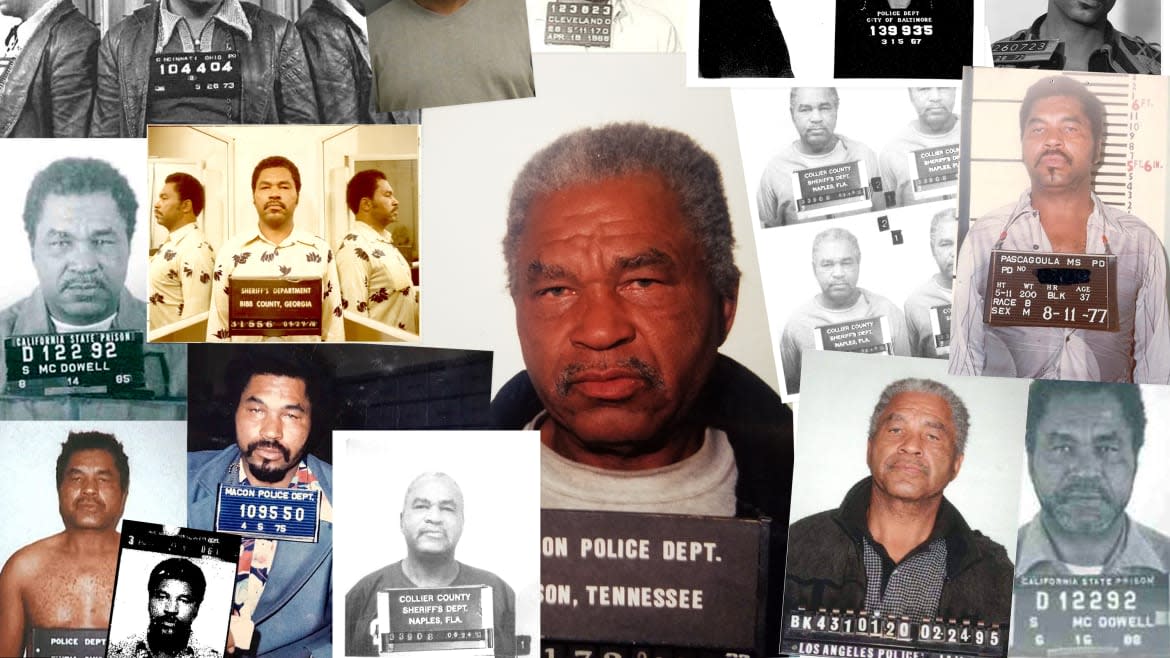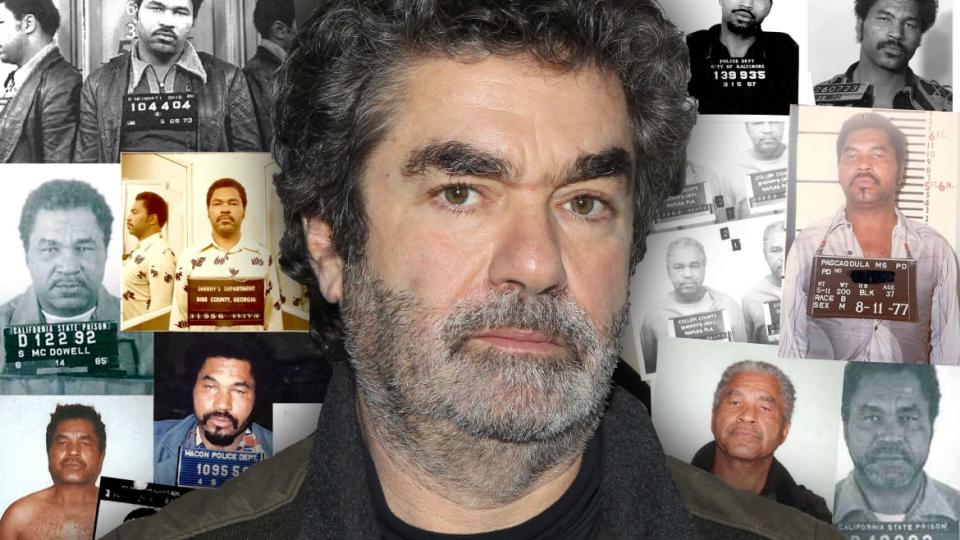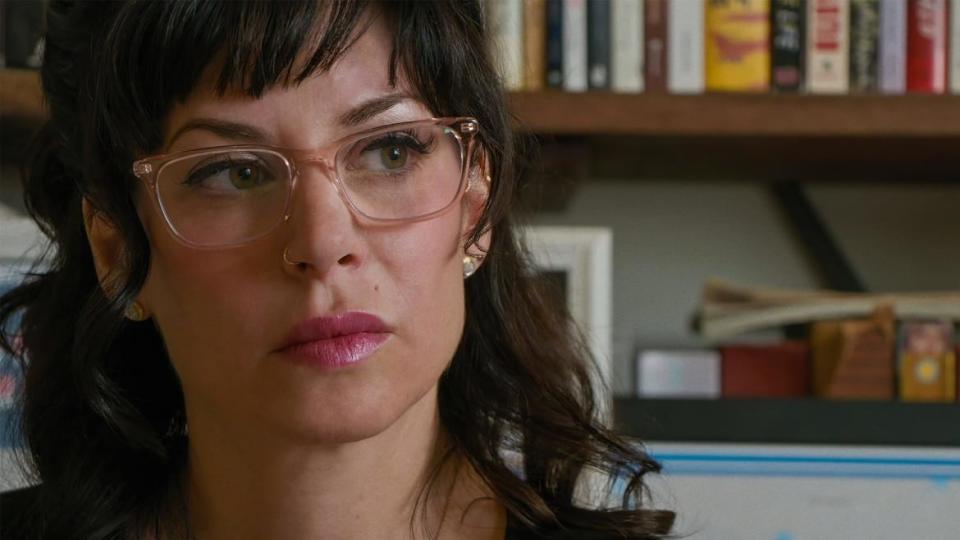Samuel Little Says He Killed 93 People. Why Don’t You Know His Name?

- Oops!Something went wrong.Please try again later.
- Oops!Something went wrong.Please try again later.
- Oops!Something went wrong.Please try again later.
Between 1970 and 2005, Samuel Little allegedly murdered 93 people, according to his own confessions. That means he killed more people than Jeffrey Dahmer, John Wayne Gacy, and Ted Bundy combined. He claims to be the most prolific serial killer in American history. So why don’t you know his name?
Starz’s new true crime docuseries Confronting a Serial Killer, premiering Sunday night, details how Little, who died in 2020, made his away across the country over the course of decades, treating back alleys, pick-up corners, and underbelly jukebox joints as his hunting ground, targeting prostitutes and drug addicts—often poor women of color—and strangling them to death.
His rap sheet over the years was over 100 pages long—rape, assault, even murder—and he was tried three times, but, despite witness testimony from survivors, he was repeatedly acquitted and spent little time in jail.
It wasn’t until DNA evidence linked him to the murders of three women in 2012 that he was finally convicted, though he still maintained his innocence. And it wasn’t until author and journalist Jillian Lauren began looking into his story, developing a relationship that evolved into almost daily phone calls from prison, that Little confessed—in graphic, disturbing detail—to his ghastly acts.
“In our system of justice, not only are perpetrators treated terribly in terms of racial equity, but if the victims of violent crime are from more marginalized communities—people of color, women of color, women in general, sex workers, people with drug issues—they’re not treated the same,” director Joe Berlinger tells The Daily Beast.
Kate Winslet’s ‘Mare of Easttown’ Is the Year’s First Great Crime Drama
How did Little literally get away with murder for so long? His victims were, as Lauren explains in the series, considered “less dead” by authorities and the judicial system, their tragedies discounted because of their race, status, and life choices. Says Berlinger, “If a white female from Yale University was killed, that crime would be treated very, very differently than all the victims of Samuel Little.”
Confronting a Serial Killer tracks how Lauren earns Little’s trust. Through her recordings of their phone conversations, you hear him boast with a disturbing, photographic memory the details of his stranglings and the fetish pleasure he took from them. She then investigates how, even when those murders were reported and survivors testified against him, detectives, lawyers, and juries neglected the cases and miscarried justice, often because the victims were deemed to be of low character or, egregiously, disposable.
No one knows better than Berlinger how popular, but also polarizing, true crime series have become. The Oscar-nominated director of the Paradise Lost trilogy, about the trials of the West Memphis Three, saw other titles in the genre he’s responsible for—Conversations With a Killer: The Ted Bundy Tapes, Murder Among the Mormons—among those skewered in a recent Saturday Night Live sketch about the macabre appeal of “murder shows” with women.
“There is an awful lot of irresponsible true crime being made that is just about wallowing in the misery of others for entertainment purposes, and to me that is despicable and it is disrespectful to the victims,” Berlinger says.
Berlinger wanted to make sure that relaying Little’s crimes carried a social justice message about the disservice that was done to his victims because of their race and socioeconomic status, an institutional bias that fostered his murder spree. Adds Lauren, “I’m very conscious about the capitalism of pain. We’re not using pain as entertainment. We’re using it to talk about humanity.”
In every respect, Little’s story is shocking. But it’s also a surprise that, given our fascination with true crime and especially serial killers, most people aren’t aware of his story. The likes of Dahmer, Gacy, and Bundy have gained great notoriety, the subjects of multiple films, documentaries, and mythologies that have turned them into cultural fixtures.
There has never been a man who has allegedly killed more people in the U.S. than Samuel Little. The reason he hasn’t joined those men in infamy may be the same reason he got away with his murder spree for so long.
“He preyed upon a particular kind of victim, who he calculated wouldn’t be missed,” Berlinger says. “It’s a horrible calculation that he was wrong about, because there were obviously people who missed their loved ones. But he was right that it would be his ticket to eluding real scrutiny, because those kinds of victims don’t raise concern to the highest levels of law enforcement.”
Lauren is as much a character in Confronting a Serial Killer as Little is. Beyond the fact that she was researching a book on him, her motivations to seek justice on behalf of his victims—she plays a part in solving several cold cases related to him—are rooted in her own experience as an assault survivor. While in her twenties, she was nearly strangled to death by her then-boyfriend, the same violent method Little would use.

Filmmaker Joe Berlinger
She spent two years speaking on the phone with Little and corresponding with him by mail. At times he treated her as a friend and confidant, eliciting pleasure in horrifying her with the violent specifics of his assaults. As Lauren’s husband says in the series, “It seems to me like he’s trying to kill her through the phone.”
Beyond that of Little, his victims, and Lauren, there’s another story being told in Confronting a Serial Killer: the toll that investigating and documenting these traumatizing murders takes on the people who are doing the storytelling.
Lauren recounts a scene during filming that didn’t make it into the series, but highlights the surreal pain she endured while coaxing confessions out of Little and working on the project. She was in her office on the phone with Little with hair dye in her roots. Her young son barged in and proudly spat a tooth out in her hand. “Sam was, like, talking about how he would cradle their bodies when they were dead, and my kid’s losing a tooth in my hand.”

Jillian Lauren in Confronting a Serial Killer
Berlinger is familiar with the tension between mission and emotional reality. He still has visceral memories of when he was editing the first Paradise Lost documentary, which told the story of three 8-year-old boys who were mutilated and murdered as part of an alleged satanic ritual and the three teenagers who were subsequently put on trial for the crime. There was a week when he was trying to figure just how much footage of the crime scene to include, which meant spending days staring at autopsy photos and crime-scene images.
“I remember going home that night and picking up my 18-month-old child in her crib and holding her, trying to have a moment of just being a new father with my first child, just seeing flashes of these horrific images that I had been looking at all week of slaughtered children,” he says. “I really resented the project at that point because I felt like my fatherly innocence was being robbed because I was staring into the abyss of pure evil.”
He’s learned to compartmentalize, and that’s why he was so impressed by Lauren’s intense communication with Little in the pursuit of winning justice for his victims. After a 45-year killing spree, he never confessed to a single murder until their conversations.
“Every time I had to hear another one of those stories, I told myself this is not about me,” she says. “It’s about social justice. It hurts a little, but it was a really gratifying process.”
Get our top stories in your inbox every day. Sign up now!
Daily Beast Membership: Beast Inside goes deeper on the stories that matter to you. Learn more.

